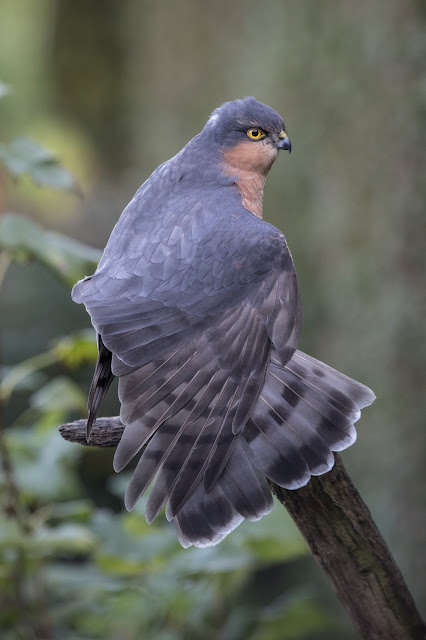This was an exciting surprise. After a series of several juvenile male sparrowhawks (see below) in the past three years, a beautiful adult male turned up. At first I thought I wouldn't be able to get a photo, because although this window is normally set up as a hide, this time it was completely unprotected. By moving very slowly I managed to get a camera into position without spooking him.
He sat for over a hour, sometimes on alert for the next kill and sometimes stretching and preening to show off all his feathers.
My friend Chris Wright, an expert ornithologist and bird ringer, says in theory this bird could be from last year (ie hatched in 2018) but after the first moult sparrowhawks retain a few feathers with (juvenile) buff tips, which are completely lacking here, suggesting it is at least two years old (ie hatched in 2017 or before).
This got me wondering if I had seen this bird before and if I could identify individuals from the last three years. Obviously feathers are no use because they are moulted and move around a lot as the bird moves but I noticed a brown mark on his cere. The cere is the waxy-looking yellow covering over the base of the upper mandible, sometimes also known as the operculum.
Looking back through photos of previous birds, below is the first adult male from Jan 2017. He has mottled brown and white marks on the cere. (Most of the photos that follow were taken with only a 200mm lens and are therefore heavily cropped.)
Five week later the appearance was the same, so these were not just dirty marks.
This is the first juvenile, who appeared in December 2018. His cere shows dimpled brown marks.
Two months later there was the same appearance, so it is the same bird and the marks persist, in the short term at least.
This was his last appearance at the end of March 2018. I don't know if the marks are cause by injury, wear, nutritional deficiency or something else and so far I can't find any information about it.
This is the next juvenile on his first appearance in November 2018. His cere appears a bit darkened and damaged or deformed in the centre.
In December it looked the same.
He was here until the end of March this year and was unchanged so it appears that these marks persist over a few months and can be used to identify an individual. What I don't know is whether the cere would heal or regrow over a longer period.
The next sparrowhawk to turn up was a rather faded and scruffy-looking juvenile at the end of July. He had several brown marks down the centre of the cere but also a bit of damage causing a transverse groove in the culmen, the ridge down the top of the upper mandible. I originally assumed he was last winter's regular bird but I now think I haven't seen him before (or since).
And this is the latest youngster, from September. He has small brown marks on the left and across the front of the cere so now I know to look out for them I should be able to keep track of him.
All this means that if the marks persist long term the present male sparrowhawk isn't one of the previous four youngsters but is a bird I haven't seen before. It also means I have had four different birds sitting on the perch in the last six months. Here are all six from the last three years, all individually recognisable.


























This is a great technique for identifying individuals. They've done work on trout in the Tweed with spot patterns, and I think there's even an app for it. It is definitely possible to Id and track individual trout, but the problem you have is rather greater I think.
ReplyDelete